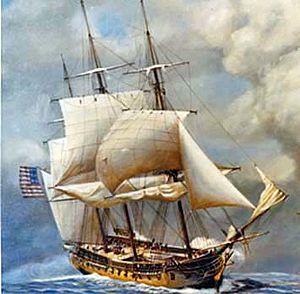Quasi-War facts for kids
Quick facts for kids Quasi-War |
|||||||
|---|---|---|---|---|---|---|---|
| Part of French Revolutionary Wars | |||||||
 USS Constellation served with distinction in the Quasi-War |
|||||||
|
|||||||
| Belligerents | |||||||
| Commanders and leaders | |||||||
| John Adams George Washington Benjamin Stoddert Alexander Hamilton |
Paul Barras Napoléon Bonaparte Edme Étienne Borne Desfourneaux Victor Hugues |
||||||
| Strength | |||||||
| A fleet of 54 including: 18 Frigates 4 Sloops 2 Brigs 3 Schooners 5,700 Sailors 365 privateers |
Unknown | ||||||
| Casualties and losses | |||||||
| 20 dead 42 wounded 300+ merchantmen and their cargoes captured 1 Privateer captured |
More than 100 privateer warships captured | ||||||
The Quasi-War was an undeclared naval war fought between the United States and the French Republic from 1798 to 1801. It was mostly fought at sea. The United States and France never officially declared war. This is why it is called the "Quasi-War," meaning "almost war."
Contents
Why the Quasi-War Started
The Quasi-War happened because of problems between the United States and France. After the American Revolutionary War, France helped the U.S. gain independence. The two countries signed a treaty of alliance in 1778. However, things changed when the French Revolution began in 1789.
France's Problems with America
France expected the U.S. to help them in their wars against other European countries, especially Great Britain. But the U.S. wanted to stay neutral. This meant they did not want to pick sides. In 1794, the U.S. signed the Jay Treaty with Great Britain. This treaty helped solve some trade issues. France saw this as the U.S. taking Britain's side.
French Attacks on U.S. Ships
Because France was angry, they started attacking American merchant ships. These ships were carrying goods for trade. French warships and privateers captured many American vessels. A privateer was a private ship given permission by a government to attack enemy ships. These attacks hurt American trade and pride.
The United States Fights Back
The U.S. government, led by President John Adams, had to respond. The American Navy was very small at this time. It had been mostly disbanded after the Revolutionary War. To protect American ships, Congress decided to rebuild the Navy.
In 1798, Congress created the Department of the Navy. They also ordered new warships to be built. Ships like the USS Constellation and USS United States were quickly put into service. These new ships were strong and fast. They were designed to fight French privateers.
Key American Leaders
Benjamin Stoddert became the first United States Secretary of the Navy. He worked hard to build up the fleet. American naval officers like Thomas Truxtun led the new ships into battle. President John Adams strongly supported these efforts.
Battles at Sea
Most of the fighting in the Quasi-War happened in the Caribbean Sea. This was a busy area for trade. American warships patrolled these waters. They protected U.S. merchant ships and hunted French privateers.
One important battle was between the USS Constellation and the French frigate L'Insurgente. This happened in February 1799. The Constellation, commanded by Captain Thomas Truxtun, captured the French ship. This was a big victory for the new American Navy.
Another notable fight was in February 1800. The USS Constellation fought the French frigate La Vengeance. This battle lasted for hours. Both ships were badly damaged. La Vengeance managed to escape, but it showed the strength of the American Navy.
Success Against Privateers
During the Quasi-War, the U.S. Navy captured more than 100 French privateer ships. This greatly reduced the attacks on American trade. It made shipping safer for U.S. merchants.
Ending the Quasi-War
The Quasi-War ended with a peace agreement. Both the United States and France wanted to stop the fighting. France was busy with wars in Europe. The U.S. wanted to focus on its own growth.
The Convention of 1800
In 1800, representatives from both countries met in France. They signed the Convention of 1800, also known as the Treaty of Mortefontaine. This treaty officially ended the alliance from 1778. It also ended the Quasi-War.
The treaty said that the U.S. would give up its claims for damages from French attacks. In return, France agreed to stop attacking American ships. The U.S. also promised to remain neutral in European wars.
Impact of the Quasi-War
The Quasi-War had several important effects on the United States.
The war showed that the U.S. needed a strong navy. It helped establish the United States Navy as a permanent part of the country's defense. The experience gained by American sailors and officers was very valuable.
U.S. Foreign Policy
The Quasi-War also helped shape American foreign policy. It reinforced the idea of U.S. neutrality in European conflicts. This policy of avoiding alliances would be important for many years. It allowed the young nation to grow without getting caught in other countries' wars.
Images for kids
-
Caribbean, main focus of operations during the Quasi-War
-
A 20th-century illustration depicting United States Marines escorting French prisoners
See also
 In Spanish: Cuasi-Guerra para niños
In Spanish: Cuasi-Guerra para niños




